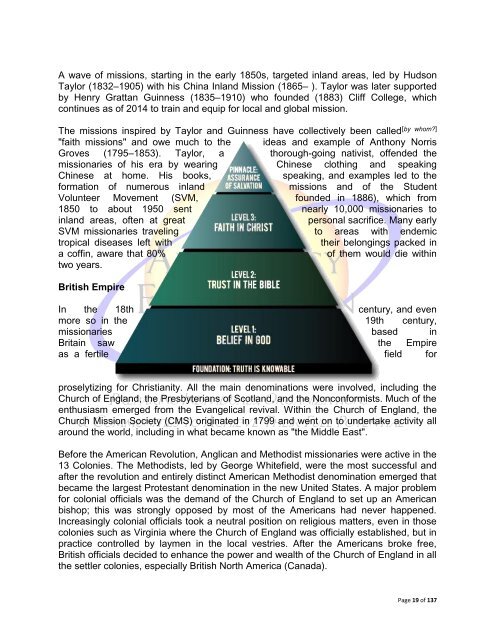The Theology of Missions
The Theology of Missions
The Theology of Missions
Create successful ePaper yourself
Turn your PDF publications into a flip-book with our unique Google optimized e-Paper software.
A wave <strong>of</strong> missions, starting in the early 1850s, targeted inland areas, led by Hudson<br />
Taylor (1832–1905) with his China Inland Mission (1865– ). Taylor was later supported<br />
by Henry Grattan Guinness (1835–1910) who founded (1883) Cliff College, which<br />
continues as <strong>of</strong> 2014 to train and equip for local and global mission.<br />
<strong>The</strong> missions inspired by Taylor and Guinness have collectively been called<br />
[by whom?]<br />
"faith missions" and owe much to the ideas and example <strong>of</strong> Anthony Norris<br />
Groves (1795–1853). Taylor, a thorough-going nativist, <strong>of</strong>fended the<br />
missionaries <strong>of</strong> his era by wearing Chinese clothing and speaking<br />
Chinese at home. His books, speaking, and examples led to the<br />
formation <strong>of</strong> numerous inland<br />
missions and <strong>of</strong> the Student<br />
Volunteer Movement (SVM, founded in 1886), which from<br />
1850 to about 1950 sent nearly 10,000 missionaries to<br />
inland areas, <strong>of</strong>ten at great<br />
personal sacrifice. Many early<br />
SVM missionaries traveling to areas with endemic<br />
tropical diseases left with<br />
their belongings packed in<br />
a c<strong>of</strong>fin, aware that 80%<br />
<strong>of</strong> them would die within<br />
two years.<br />
British Empire<br />
In the 18th century, and even<br />
more so in the 19th century,<br />
missionaries based in<br />
Britain saw the Empire<br />
as a fertile field for<br />
proselytizing for Christianity. All the main denominations were involved, including the<br />
Church <strong>of</strong> England, the Presbyterians <strong>of</strong> Scotland, and the Nonconformists. Much <strong>of</strong> the<br />
enthusiasm emerged from the Evangelical revival. Within the Church <strong>of</strong> England, the<br />
Church Mission Society (CMS) originated in 1799 and went on to undertake activity all<br />
around the world, including in what became known as "the Middle East".<br />
Before the American Revolution, Anglican and Methodist missionaries were active in the<br />
13 Colonies. <strong>The</strong> Methodists, led by George Whitefield, were the most successful and<br />
after the revolution and entirely distinct American Methodist denomination emerged that<br />
became the largest Protestant denomination in the new United States. A major problem<br />
for colonial <strong>of</strong>ficials was the demand <strong>of</strong> the Church <strong>of</strong> England to set up an American<br />
bishop; this was strongly opposed by most <strong>of</strong> the Americans had never happened.<br />
Increasingly colonial <strong>of</strong>ficials took a neutral position on religious matters, even in those<br />
colonies such as Virginia where the Church <strong>of</strong> England was <strong>of</strong>ficially established, but in<br />
practice controlled by laymen in the local vestries. After the Americans broke free,<br />
British <strong>of</strong>ficials decided to enhance the power and wealth <strong>of</strong> the Church <strong>of</strong> England in all<br />
the settler colonies, especially British North America (Canada).<br />
Page 19 <strong>of</strong> 137

















